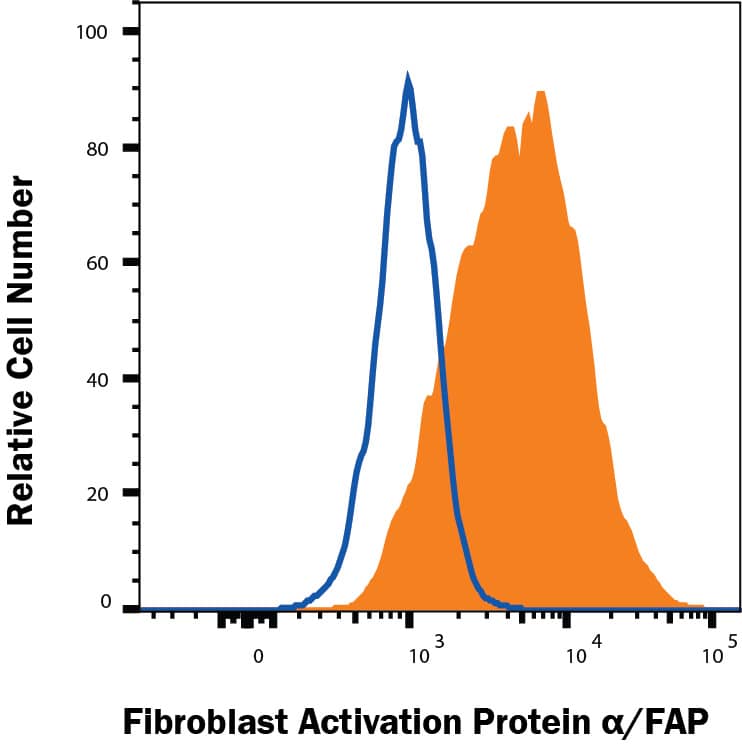Human Fibroblast Activation Protein alpha/FAP Alexa Fluor® 647-conjugated Antibody
R&D Systems, part of Bio-Techne | Catalog # FAB3715R


Key Product Details
Species Reactivity
Validated:
Cited:
Applications
Validated:
Cited:
Label
Antibody Source
Product Specifications
Immunogen
Leu26-Asp760
Accession # Q12884
Specificity
Clonality
Host
Isotype
Scientific Data Images
Detection of Fibroblast Activation Protein alpha /FAP in WI‑38 Human Cell Line by Flow Cytometry.
WI-38 human lung fibroblast cell line was stained with Mouse Anti-Human Fibroblast Activation Protein alpha /FAP Alexa Fluor® 647-conjugated Monoclonal Antibody (Catalog # FAB3715R, filled histogram) or isotype control antibody IC002R, open histogram). View our protocol for Staining Membrane-associated Proteins.Detection of Fibroblast Activation Protein alpha/FAP in U87MG cells by Flow Cytometry.
U87MG cells were stained with Mouse Anti-Human Fibroblast Activation Protein alpha/FAP Alexa Fluor® 647-conjugated Monoclonal Antibody (Catalog # FAB3715R, filled histogram) or isotype control antibody (Catalog # IC002R, open histogram). View our protocol for Staining Membrane-associated Proteins.Applications
Flow Cytometry
Formulation, Preparation, and Storage
Purification
Formulation
Shipping
Stability & Storage
- 12 months from date of receipt, 2 to 8 °C as supplied.
Background: Fibroblast Activation Protein alpha/FAP
FAP (also known as Seprase) is a 97 kDa Type II transmembrane serine protease that is structurally related to Dipeptidyl Peptidase IV (DPPIV) (1). FAP has substrate specificity similar to DPPIV, which is specific for N-terminal Xaa-Pro sequences, but FAP is also an endopeptidase able to degrade gelatin and Type I Collagen (2). The enzymatically active form of FAP is a dimer that migrates at ~170 kDa. It is associated with multiple integral membrane proteins such as Integrin alpha3 beta1, UPA and DPPIV (3,4). FAP has a restricted tissue distribution. It is occasionally detected in fibroblasts and pancreatic islet cells, but is highly expressed on reactive stromal fibroblasts in epithelial cancers, in granulation tissue during wound healing, and in bone and soft tissue sarcomas (4-6). Because of its expression patterns and enzymatic activities, FAP is believed to play roles in tumor invasion, tissue remodeling, and wound repair. The 760 amino acid (aa) human FAP contains a 735 aa extracellular domain that is glycosylated and necessary for activity (4). It shares 90% aa identity with mouse and rat FAP. A reported 672 aa splicing variant diverges prior to the active site charge relay residues at the C-terminus.
References
- Scanlan, M.J. et al. (1994) Proc. Natl. Acad. Sci. USA 91:5657.
- Park, J.E. et al. (1999) J. Biol. Chem. 274:36505.
- Pineiro-Sanchez, M.L. et al. (1997) J. Biol. Chem. 272:7595.
- O'Brien, P. and B.F. O'Connor (2008) Biochim. Biophys. Acta 1784:1130.
- Garin-Chesa, P. et al. (1990) Proc. Natl. Acad. Sci. USA 87:7235.
- Rettig, W.J. et al. (1988) Proc. Natl. Acad. Sci. USA 85:3110.
Alternate Names
Gene Symbol
UniProt
Additional Fibroblast Activation Protein alpha/FAP Products
- All Products for Fibroblast Activation Protein alpha/FAP
- Fibroblast Activation Protein alpha/FAP cDNA Clones
- Fibroblast Activation Protein alpha/FAP ELISA Kits
- Fibroblast Activation Protein alpha/FAP Lysates
- Fibroblast Activation Protein alpha/FAP Primary Antibodies
- Fibroblast Activation Protein alpha/FAP Proteins and Enzymes
- Fibroblast Activation Protein alpha/FAP Simple Plex
Product Specific Notices
This product is provided under an agreement between Life Technologies Corporation and R&D Systems, Inc, and the manufacture, use, sale or import of this product is subject to one or more US patents and corresponding non-US equivalents, owned by Life Technologies Corporation and its affiliates. The purchase of this product conveys to the buyer the non-transferable right to use the purchased amount of the product and components of the product only in research conducted by the buyer (whether the buyer is an academic or for-profit entity). The sale of this product is expressly conditioned on the buyer not using the product or its components (1) in manufacturing; (2) to provide a service, information, or data to an unaffiliated third party for payment; (3) for therapeutic, diagnostic or prophylactic purposes; (4) to resell, sell, or otherwise transfer this product or its components to any third party, or for any other commercial purpose. Life Technologies Corporation will not assert a claim against the buyer of the infringement of the above patents based on the manufacture, use or sale of a commercial product developed in research by the buyer in which this product or its components was employed, provided that neither this product nor any of its components was used in the manufacture of such product. For information on purchasing a license to this product for purposes other than research, contact Life Technologies Corporation, Cell Analysis Business Unit, Business Development, 29851 Willow Creek Road, Eugene, OR 97402, Tel: (541) 465-8300. Fax: (541) 335-0354.
For research use only
